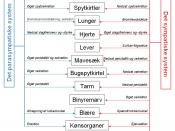physiological psychology a. describe the main features of Selye's General Adaption Syndrome.
Selye introduced the term stress in the 1950's with detailed studies of the physiological changes that take place over conditions of short term and long term stress, The research was based on various experiments tested on lab animals, mainly rats. Stressors, he argued all produced much the same reaction, at least the same general bodily response, he therefore defined stress as "ÃÂ the non-specific response of the body to any demand made upon it "ÃÂ (1956) "ÃÂGeneral' in the General Adaption Syndrome refers to his belief there is the same general bodily response to all stressors. "ÃÂAdaption' refers to his view that the stress response enables organisms to adapt to stressors. "ÃÂSyndrome' is a typical or characteristic combination of factors that make up the stress response. Within the G.A.S, there are three stages, the Alarm reaction, the Resistance Stage, and the Exhaustion Stage, these stages divide up the way a subject deals with stress as a bodily response, the first stage is an abrupt reaction to a stressor, an increase in arousal in the autonomic nervous system causes the adrenaline and noradrenaline within the body to be released, this increases the rate and strength of the heart.
As a result, a reaction such as Cannons "ÃÂfight or flight' response can occur. If the reaction to such incidents within this stage is too great however, they can be life threatening, the shock from the physiological changes can lead to a heart attack. The resistance stage of the G.A.S occurs when the stressor is not abrupt, but is persistent upon the subject, this stage occurs after alarm symptoms of the first stage disappear, giving the impression that the stressor has passed, however if new stressors are introduced, the...


